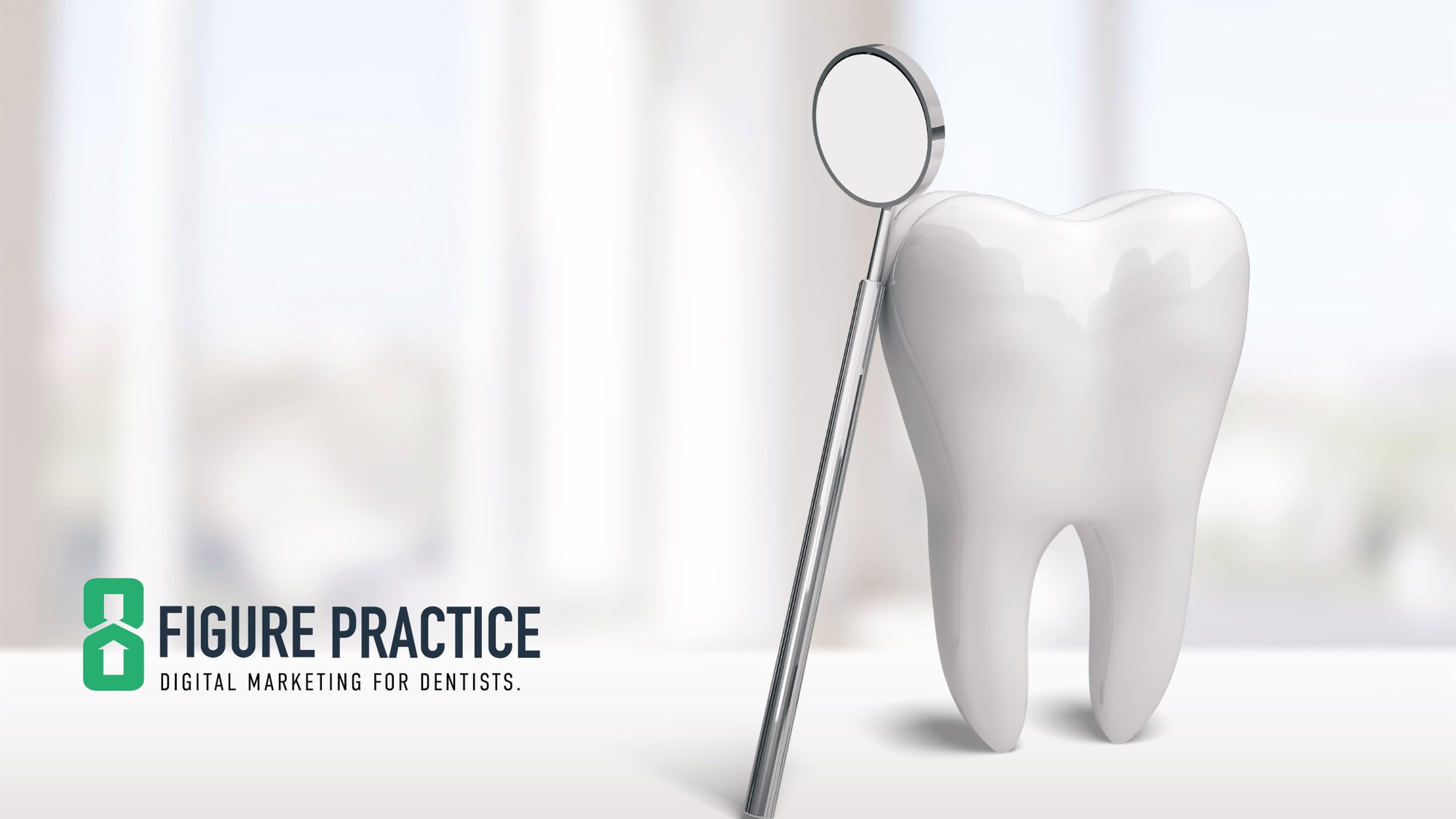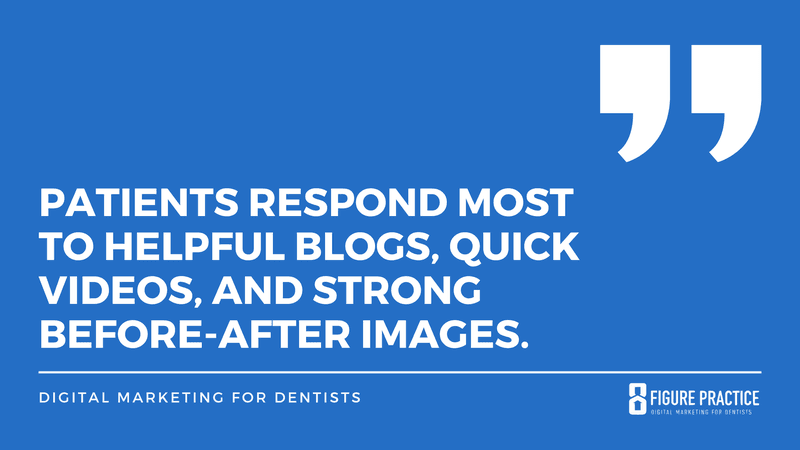
If you’re a dentist trying to grow or sell your practice, digital marketing matters more than ever. But much of the advice available is vague, or worse, outdated. We’ve worked with practices focused on growth and understand what works right now. We’ll explain clear, effective tactics in digital marketing for dentists that attract high-value patients, increase practice value, and help you grow without wasting time or budget. Let’s get into it.
Key Takeaways:
- Top 3 channels for attracting new dental patients: Local SEO, Google Business Profile, and Google Ads.
- Local SEO improves visibility for “dentist near me” searches and can double or triple patient calls if appearing in Google’s Map Pack.
- Google Business Profiles are seen three times more than dental websites, and therefore, they must be fully filled out to perform well.
- Google Ads work well for urgent needs; Facebook Ads help build awareness at a lower cost.
- Dental websites must load quickly on mobile, have clear navigation, and strong calls to action to convert traffic into bookings.
- Instagram and Facebook help build trust—use real team photos and encourage team involvement.
- Blogs, videos, and before-after cases perform best; post 1–2 times per month for better SEO.
- KPIs to track: leads, conversions, traffic, and ROI. Use tools like Google Analytics and CallRail.
- Email marketing keeps patients engaged through reminders, updates, and segmented offers—it must follow HIPAA guidelines.
- Outsource marketing if doing it yourself leads to missed opportunities, compliance risks, or outdated tools.
The Best Digital Marketing Strategies for Dentists
The fastest way to bring in new patients is to meet them where they are already searching: Google. Therefore, practices must focus on tools like Local SEO, Google Business Profiles, and Google Ads. These channels effectively place your name in front of patients actively looking for nearby care, often in real time and directly from a phone. Additionally, these strategies ensure that you stay competitive in a digital-first world. Social media also plays an important role by building trust and brand recognition, but search is still the most powerful driver for patients who are ready to book.
The Most Effective Digital Channels for Patient Growth
The top three channels for digital marketing for dentists are:
- Local SEO
- Google Business Profile
- Google Ads
Each of these connects with patients at different stages of their journey. Search-based tools reach patients who are actively looking, while social platforms like Instagram and Facebook create ongoing awareness. Practices using both remain visible and competitive.
The Importance of Local SEO for Dentists
Local SEO helps dentists appear for searches such as “dentist near me.” These searches are high-intent, meaning the person is ready to call or book. Appearing in Google’s Maps “3-pack” can generate two to three times more phone calls than being listed lower.
Steps to improve Local SEO:
- To begin with, select accurate service categories, such as Emergency Dentist, Family Dentistry, and Cosmetic Dentistry.
- Additionally, keep hours and contact details updated everywhere.
- Furthermore, complete every section in your Google Business Profile.
- Moreover, add photos and links to your website.
- Finally, gather reviews and respond to each one consistently.
When done correctly, Local SEO ensures your practice shows up for patients in your area who are ready to choose a provider.
Why Google Business Profiles Drive Visibility
Google reports that Business Profiles receive three times more views than typical dental websites. These profiles appear directly in search results and include calls, directions, reviews, and even booking links.
To maximize results, practices should:
- Use consistent name, address, and phone number across all listings
- Share weekly updates, services, and photos
- Request Google reviews in-office with a QR code
- Add appointment booking links
This creates a dynamic profile that stays high in searches and gives users an easy path to connect.

The Role of Paid Advertising for Dentists
Paid advertising provides speed. For instance, Google Ads appear above organic listings and let you target by keyword, ZIP code, or office hours. Additionally, you only pay when someone clicks.
In contrast, Facebook Ads are designed more for awareness. They help promote brand visibility and work well for cosmetic services or family-oriented campaigns. By targeting age groups or interests, you connect with patients who may not be searching yet, but who still need your services.
To avoid wasted spend, track calls and conversions using software like CallRail and adjust messaging frequently.
Why Your Dental Website Still Matters
Even with ads and search tools, your website remains the centerpiece of your online presence. Therefore, it must load fast, look professional on mobile, and make booking easy.
Website success checklist:
- Ensure a clear “Book Now” button is visible on every page.
- Adopt a mobile-first design that adjusts seamlessly to small screens.
- Place reviews and testimonials above the fold for quick reassurance.
- Use authentic team photos rather than stock images.
- Employ short, direct language written for patients, not dentists.
Ultimately, every marketing channel, social, search, and reviews, drives traffic to your site. Consequently, if your site cannot convert, your growth stalls.
Building a Complete Dentist’s Digital Marketing Strategy
A complete dental marketing strategy includes:
- Google Business Profile set up and fully optimized
- SEO-focused website with dedicated service pages
- Local SEO with city-based keywords and directory listings
- Paid ads to fill schedules while SEO builds
- Consistent reviews and responses
- Social media activity with authentic team and patient content
- Ongoing performance review of calls, clicks, and conversions
This integrated approach not only reduces risk but also builds reputation and ensures sustainable patient flow.
How Dentists Can Use Social Media to Build Community
Facebook and Instagram remain the best-fit platforms for most dental practices. They allow your team to show personality, highlight culture, and share educational posts.
Best practices for dental social media:
- Post consistent updates at least once per week
- Highlight staff, office events, and behind-the-scenes content
- Feature patient stories or smiles with written consent
- Use branded hashtags such as #SmileWithDrLee
A quick response to comments and questions humanizes your practice and builds loyalty. TikTok can be effective for younger audiences, but needs extra creativity to succeed.
Photography and HIPAA-Compliant Content
High-quality, well-lit images improve engagement and signal professionalism. Avoid stock photos whenever possible. Use natural lighting or a ring light for consistency and focus shots tightly around the smile. Always secure written consent before posting any patient image to remain HIPAA-compliant.
Optimizing Dental Websites for Conversions
A strong site gently guides each visitor toward booking.
User experience fixes that hold attention:
- Pages load within three seconds
- Booking buttons are large and visible
- Content sits no deeper than three clicks away
- Clear service landing pages with maps and CTAs
Most traffic today is mobile, so the experience needs to be smooth on phones. Avoid pop-ups, use one-column layouts, and insert click-to-call buttons for one-tap scheduling. Icons next to services, hours, or forms also improve readability.
SEO Digital Marketing for Dentists: Long-Term Organic Growth
SEO drives ongoing visibility without the cost of ads.
- Local SEO focuses on nearby searches and Google maps visibility.
- Traditional SEO strengthens your website with fast load times, rich keywords, and external links.
SEO tips:
- Use practical keywords like “family dentist in South Bay” or “cosmetic dentist Atlanta.”
- Refresh old blog posts yearly.
- Write content that answers patient-friendly questions such as “What happens during a root canal?”
Digital Marketing for Dentists: The Value of Paid Advertising Plans
PPC ads help fill schedules quickly if managed correctly. Firstly, ads should match specific services, and importantly, avoid broad keywords. Moreover, ensure clicks are directed to relevant service pages (not the homepage). Additionally, use location targeting to keep costs efficient.
Monitor results weekly. If ads generate clicks but not bookings, experiment with new headlines, keywords, or visuals.
Using Email Marketing for Patient Retention
Emails help practices maintain contact between appointments. Effective campaigns can include reminders, seasonal offers, oral health tips, and birthday messages. Moreover, by segmenting lists by age, treatment, or interests, you can make the content feel personalized.
HIPAA Tip: never include treatment details or identifiable health information unless using compliant tools and clear consent.
Explore more in Eight Figure Practice’s digital marketing news.
Online Reviews and Reputation Management
Reviews remain one of the strongest patient decision factors. Responding to both positive and negative feedback boosts credibility.
- Encourage Google reviews with easy QR codes at checkout
- Reply to every review briefly and professionally
- Never include health details in replies
Google, Yelp, and Healthgrades are the top platforms to monitor regularly.
Content Marketing for Long-Term Patient Loyalty
Digital content marketing for dentists builds trust, strengthens brand authority, and offers long-tail search growth.
High-performing content includes:
- Blog posts answering patient FAQs
- Short videos on common procedures
- Before-and-after photos with consent
Aim for one blog or video per month. Topics should also come from real patient questions and current dental news.
For more, read Is Video Marketing for Dentists Worthwhile?.
Tracking Marketing Performance
Data replaces guesswork. Focus on metrics like leads, conversion rates, website traffic, and ROI. Use Google Analytics, Facebook Insights, and CallRail to identify which campaigns bring patients. Adjust content and ads based on results to maximize growth.
| Metric | Purpose | Tool Example |
|---|---|---|
| Leads | Contacts: calls, forms | CallRail |
| Conversions | Booked appointments | CRM/Booking system |
| Traffic | Audience volume | Google Analytics |
| Engagement | Video and social reach | Facebook Insights |
Analytics also improve patient experience by showing where users stall on your site. For instance, if no one completes your form, shorten it.
When to Outsource Digital Marketing for Dentists
Most practices outsource when trying to handle marketing slows operations or adds risk. If you lack visibility in search, ads return poor results, or reviews are inconsistent, it may be time.
The right partner should also offer proof through case studies, HIPAA compliance, SEO expertise, and a clear focus on measurable patient outcomes.
Key Takeaways
- Google tools drive the strongest results for new patient acquisition.
- Websites must be mobile-optimized, fast, and conversion-focused.
- Social media builds trust and supports community engagement.
- SEO offers sustainable, low-cost growth while ads bring speed.
- Reviews, clear branding, and content marketing complete the strategy.
Ready to Grow with Proven Digital Marketing?
The path to more patients and stronger practice value begins with a clear strategy. Our team at Eight Figure Practice helps dentists scale with effective Local SEO, paid ads, websites, video, and content strategies. Build growth with proven systems, not guesswork. Explore how we can help by visiting Eight Figure Practice or dive deeper into the benefits of video marketing for dentists.
